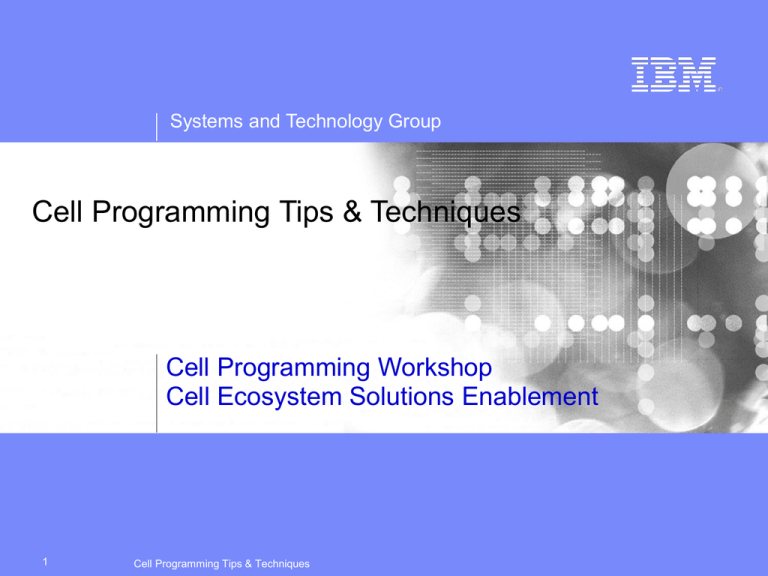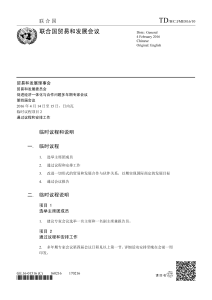
Systems and Technology Group
Cell Programming Tips & Techniques
Cell Programming Workshop
Cell Ecosystem Solutions Enablement
1
Cell Programming Tips & Techniques
Systems and Technology Group
Class Objectives – Things you will learn
Key programming techniques to exploit cell
hardware organization and language features for
– SPU
– SIMD
2
Cell Programming Tips & Techniques
Systems and Technology Group
Class Agenda
Review relevant SPE Features
SPU Programming Tips
– Level of Programming (Assembler, Intrinsics, Auto-Vectorization)
– Overlap DMA with computation (double, multiple buffering)
– Dual Issue rate (Instruction Scheduling)
– Design for limited local store
– Branch hints or elimination
– Loop unrolling and pipelining
– Integer multiplies (avoid 32-bit integer multiplies)
– Shuffle byte instructions for table look-ups
– Avoid scalar code
– Choose the right SIMD strategy
– Load / Store only by quadword
SIMD Programming Tips
3
Cell Programming Tips & Techniques
Systems and Technology Group
Review Cell Architecture
4
Cell Programming Tips & Techniques
Systems and Technology Group
Cell Processor
5
Cell Programming Tips & Techniques
Systems and Technology Group
Course Agenda
Cell Blade Products
Cell Blade Family of Servers
Cell Blade Architecture
Cell Blade Overview
– Critical signals, link speed and bandwidth
– Power consumption
– Hardware components
Blade and blade center assembly
Example of a cell blade with maximum interconnection capability
Options - Infiniband
References: Dan Brokenshire, BE Programming Tips
Trademarks: Cell Broadband Engine ™ is a trademark of Sony Computer Entertainment, Inc.
6
Cell Programming Tips & Techniques
Systems and Technology Group
Key SPE Features
7
Cell Programming Tips & Techniques
Systems and Technology Group
SPE – Single-Ported Local Memory
8
Cell Programming Tips & Techniques
Systems and Technology Group
SPU Programming Tips
9
Cell Programming Tips & Techniques
Systems and Technology Group
SPU Programming Tips
Level of Programming (Assembler, Intrinsics, Auto-Vectorization)
Overlap DMA with computation (double, multiple buffering)
Dual Issue rate (Instruction Scheduling)
Design for limited local store
Branch hints or elimination
Loop unrolling and pipelining
Integer multiplies (avoid 32-bit integer multiplies)
Shuffle byte instructions for table look-ups
Avoid scalar code
Choose the right SIMD strategy
Load / Store only by quadword
10
Cell Programming Tips & Techniques
Systems and Technology Group
Programming Levels on Cell BE
Trade-Off
Performance vs. Effort
Expert level
– Assembler, high performance, high efforts
More ease of programming
– C compiler, vector data types, intrinsics, compiler schedules
instructions + allocates registers
Auto-SIMDization
– for scalar loops, user should support by alignment directives,
compiler provides feedback about SIMDization
Highest degree of ease of use
– user-guided parallelization necessary, Cell BE looks like a
single processor
Requirements for Compiler increasing with each level
11
Cell Programming Tips & Techniques
Systems and Technology Group
Overlap DMA with computation
Double or multi-buffer code or (typically)
data
Example for double bufferign n+1 data
blcoks:
– Use multiple buffers in local store
– Use unique DMA tag ID for each buffer
– Use fence commands to order DMAs within
a tag group
– Use barrier commands to ordr DMAs within
a queue
12
Cell Programming Tips & Techniques
Systems and Technology Group
Start DMAs from SPU
Use SPE-initiated DMA transfers rather than PPEinitiated DMA transfers, because
– there are more SPEs than the one PPE
– the PPE can enqueue only eight DMA requests whereas
each SPE can enqueue 16
13
Cell Programming Tips & Techniques
Systems and Technology Group
Instruction Scheduling
14
Cell Programming Tips & Techniques
Systems and Technology Group
Instruction Starvation Situation
Dual-Issue
Instruction
Logic
There are 2 instruction buffers
– up to 64 ops along the fall-through
path
initiate
refill
after
half
empty
15
FP
MEM
FP
MEM
FP
MEM
FP
MEM
FP
MEM
FP
MEM
FP
MEM
FP
MEM
FP
MEM
FP
MEM
FP
MEM
FP
MEM
FP
MEM
FP
MEM
FP
MEM
FP
MEM
FP
MEM
FP
MEM
FP
MEM
FP
MEM
FP
MEM
FP
MEM
FP
MEM
FP
MEM
FP
MEM
FP
MEM
FP
MEM
FP
MEM
FP
MEM
FP
MEM
instruction
buffers
FP
MEM
FP
MEM
Cell Programming Tips & Techniques
First buffer is half-empty
– can initiate refill
When MEM port is continuously
used
– starvation occurs (no ops left in
buffers)
Systems and Technology Group
Instruction Starvation Prevention
Dual-Issue
Instruction
Logic
initiate
refill
after
half
empty
16
FP
MEM
FP
MEM
FP
MEM
FP
MEM
FP
MEM
FP
MEM
FP
MEM
FP
MEM
FP
MEM
FP
MEM
FP
MEM
FP
MEM
FP
MEM
FP
MEM
FP
MEM
FP
MEM
FP
MEM
FP
MEM
FP
MEM
FP
MEM
FP
MEM
FP
MEM
FP
MEM
FP
MEM
instruction buffer
Cell Programming Tips & Techniques
before
it is too
late to
hide
latency
SPE has an explicit IFETCH op
– which initiates an instruction
fetch
Scheduler monitors starvation
situation
– when MEM port is
continuously used
– insert IFETCH op within the
(red) window
refill IFETCH latency
Compiler design
– scheduler must keep track of
code layout
Systems and Technology Group
Design for Limited Local Store
The Local Store holds up to 256 KB for
– the program, stack, local data structures, and DMA
buffers.
Most performance optimizations put pressure on
local store (e.g. multiple DMA buffers)
Use plug-ins (runtime download program kernels)
to build complex function servers in the LS.
17
Cell Programming Tips & Techniques
Systems and Technology Group
Branch Optimizations
SPE
– Heavily pipelined high penalty for branch misses (18 cycles)
– Hardware policy: assume all branches are not taken
Advantage
– Reduced hardware complexity
– Faster clock cycles
– Increased predictability
Solution approaches
– If-conversions: compare and select operations
– Predications/code re-org: compiler analysis, user directives
– Branch hint instruction (hbr, 11 cycles before branch)
18
Cell Programming Tips & Techniques
Systems and Technology Group
Branches
19
Cell Programming Tips & Techniques
Systems and Technology Group
20
Cell Programming Tips & Techniques
Systems and Technology Group
Hinting Branches & Instruction Starvation Prevention
Dual-Issue
Instruction
Logic
FP
MEM
FP
MEM
FP
MEM
FP
MEM
FP
MEM
FP
MEM
FP
MEM
FP
MEM
FP
MEM
FP
MEM
FP
MEM
FP
MEM
FP
MEM
FP
MEM
FP
MEM
FP
MEM
FP
MEM
FP
MEM
FP
MEM
FP
MEM
FP
MEM
FP
MEM
FP
MEM
FP
MEM
FP
MEM
FP
MEM
FP
MEM
FP
MEM
FP
MEM
FP
MEM
FP
MEM
FP
MEM
FP
MEM
FP
MEM
FP
MEM
FP
MEM
FP
MEM
FP
MEM
FP
MEM
FP
MEM
FP
MEM
FP
MEM
FP
MEM
FP
MEM
FP
MEM
FP
MEM
FP
MEM
FP
MEM
instruction buffers
21
HINT buffer
Cell Programming Tips & Techniques
SPE provides a HINT operation
– fetches the branch target into HINT
buffer
– no penalty for correctly predicted
branches
IFETCH
window
refill
latency
HINT br, target
fetches ops from target;
needs a min of 15 cycles
and 8 intervening ops
BRANCH if true
target
– compiler inserts hints when beneficial
Impact on instruction starvation
– after a correctly hinted branch,
IFETCH window is smaller
Systems and Technology Group
Loop Unrolling
– Unroll loops
• to reduce dependencies
• increase dual-issue rates
– This exploits the large SPU register file.
– Compiler auto-unrolling is not perfect, but pretty good.
22
Cell Programming Tips & Techniques
Systems and Technology Group
Loop Unrolling - Examples
j=N;
a[1] = (b[1] + b[N]) / 2;
For(i=1, i<N, i++) {
For(i=2, i<N, i++) {
a[i] = (b[i] + b[j]) / 2;
j = i;
a[i] = (b[i] + b[i-1]) / 2;
}
}
For(i=1, i<100, i++) {
For(i=1, i<99, i+=2) {
a[i] = b[i+2] * c[i-1];
a[i] = b[i+2] * c[i-1];
a[i+1] = b[i+3] * c[i];
}
}
23
Cell Programming Tips & Techniques
Systems and Technology Group
SPU
24
Cell Programming Tips & Techniques
Systems and Technology Group
SPU – Software Pipeline
25
Cell Programming Tips & Techniques
Systems and Technology Group
Integer Multiplies
Avoid integer multiplies on operands greater than 16 bits
– SPU supports only a 16-bit x16-bit multiply
– 32-bit multiply requires five instructions (three 16-bit multiplies
and two adds)
Keep array elements sized to a power-of-2 to avoid
multiplies when indexing.
Cast operands to unsigned short prior to multiplying.
Constants are of type int and also require casting.
Use a macro to explicitly perform 16-bit multiplies. This can
avoid inadvertent introduction of signed extends and masks
due to casting.
#define MULTIPLY(a, b)\
(spu_extract(spu_mulo((vector unsigned short)spu_promote(a,0),\
(vector unsigned short)spu_promote(b, 0)),0))
26
Cell Programming Tips & Techniques
Systems and Technology Group
Avoid Scalar Code
27
Cell Programming Tips & Techniques
Systems and Technology Group
Choose an SIMD strategy appropriate for your algorithm
Evaluate array-of-structure (AOS) organization
– For graphics vertices, this organization (also called or
vector-across) can have more-efficient code size and
simpler DMA needs,
– but less-efficient computation unless the code is unrolled.
Evaluate structure-of-arrays (SOA) organization.
– For graphics vertices, this organization (also called
parallel-array) can be easier to SIMDize,
– but the data must be maintained in separate arrays or the
SPU must shuffle AOS data into an SOA form.
28
Cell Programming Tips & Techniques
Systems and Technology Group
Choose SIMD strategy appropriate for algorithm
vec-across
– More efficient code size
– Typically less efficient
code/computation
unless code is unrolled
– Typically simpler DMA needs
parallel-array
– Easy to SIMD – program as if scalar, operating on 4 independent
objects at a time
– Data must be maintained in separate arrays or SPU must shuffle vecacross data into a parallel array form
Consider unrolling affects when picking SIMD strategy
29
Cell Programming Tips & Techniques
Systems and Technology Group
SIMD Example
30
Cell Programming Tips & Techniques
Systems and Technology Group
Load / Store by Quadword
Scalar loads and stores are slow, with long
latency.
SPUs only support quadword loads and stores.
Consider making scalars into quadword integer
vectors.
Load or store scalar arrays as quadwords, and
perform your own extraction and insertion to
eliminate load and store instructions.
31
Cell Programming Tips & Techniques
Systems and Technology Group
SIMD Programming Tips
32
Cell Programming Tips & Techniques
Systems and Technology Group
33
Cell Programming Tips & Techniques
Systems and Technology Group
34
Cell Programming Tips & Techniques
Systems and Technology Group
35
Cell Programming Tips & Techniques
Systems and Technology Group
36
Cell Programming Tips & Techniques
Systems and Technology Group
37
Cell Programming Tips & Techniques
Systems and Technology Group
38
Cell Programming Tips & Techniques
Systems and Technology Group
39
Cell Programming Tips & Techniques
Systems and Technology Group
40
Cell Programming Tips & Techniques
Systems and Technology Group
Use Offset Pointer
Use the PPE’s load/store with update instructions. These allow sequential
indexing through an array without the need of additional instructions to increment
the array pointer.
For the SPEs (which do not support load/store with update instructions), use the
d-form instructions to specify an immediate offset from a base array pointer
For example, consider the following PPE code that exploits the PowerPC store
with update instruction:
#define FILL_VEC_FLOAT(_q, _data) *(vector float)(_q++) = _data;
FILL_VEC_FLOAT(q, x);
FILL_VEC_FLOAT(q, y);
FILL_VEC_FLOAT(q, z);
FILL_VEC_FLOAT(q, w);
The same code can be modified for SPU execution as follows:
#define FILL_VEC_FLOAT(_q, _offset, _data) *(vector float)(_q+(_offset)) = _data;
FILL_VEC_FLOAT(q, 0, x);
FILL_VEC_FLOAT(q, 1, y);
FILL_VEC_FLOAT(q, 2, z);
FILL_VEC_FLOAT(q, 3, w);
q += 4;
41
Cell Programming Tips & Techniques
Systems and Technology Group
Shuffle byte instructions for table look-ups
42
Cell Programming Tips & Techniques
Systems and Technology Group
(c) Copyright International Business Machines Corporation 2005.
All Rights Reserved. Printed in the United Sates September 2005.
The following are trademarks of International Business Machines Corporation in the United States, or other countries, or both.
IBM
IBM Logo
Power Architecture
Other company, product and service names may be trademarks or service marks of others.
All information contained in this document is subject to change without notice. The products described in this document are
NOT intended for use in applications such as implantation, life support, or other hazardous uses where malfunction could result
in death, bodily injury, or catastrophic property damage. The information contained in this document does not affect or change
IBM product specifications or warranties. Nothing in this document shall operate as an express or implied license or indemnity
under the intellectual property rights of IBM or third parties. All information contained in this document was obtained in specific
environments, and is presented as an illustration. The results obtained in other operating environments may vary.
While the information contained herein is believed to be accurate, such information is preliminary, and should not be relied
upon for accuracy or completeness, and no representations or warranties of accuracy or completeness are made.
THE INFORMATION CONTAINED IN THIS DOCUMENT IS PROVIDED ON AN "AS IS" BASIS. In no event will IBM be liable
for damages arising directly or indirectly from any use of the information contained in this document.
IBM Microelectronics Division
1580 Route 52, Bldg. 504
Hopewell Junction, NY 12533-6351
43
Cell Programming Tips & Techniques
The IBM home page is http://www.ibm.com
The IBM Microelectronics Division home page is
http://www.chips.ibm.com



